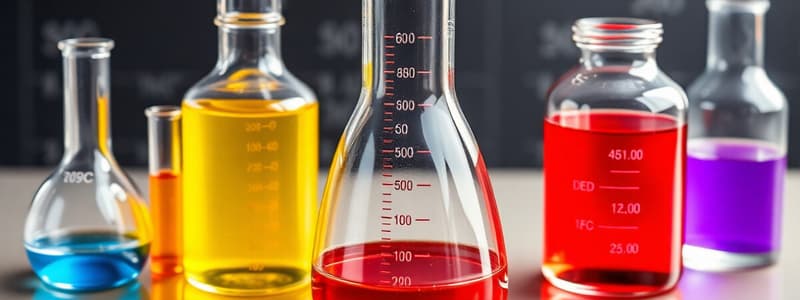Podcast
Questions and Answers
What is the primary function of air displacement in the context of a centrifuge?
What is the primary function of air displacement in the context of a centrifuge?
- To maintain liquid contact with the piston
- To use suction for sample aspiration (correct)
- To ensure maximum capacity of liquid transfer
- To heat the sample during operation
Which parameter is not typically checked to ensure quality control in air displacement methods?
Which parameter is not typically checked to ensure quality control in air displacement methods?
- Humidity (correct)
- Temperature
- Timer
- Speed
How does a positive displacement method operate compared to air displacement?
How does a positive displacement method operate compared to air displacement?
- It employs a complex electronic system
- It draws liquid directly with the piston (correct)
- It maintains an air gap during operation
- It does not use a piston
What characteristic defines Type I reagent water compared to Types II and III?
What characteristic defines Type I reagent water compared to Types II and III?
Which component is essential in a positive displacement pipette system?
Which component is essential in a positive displacement pipette system?
What is a primary characteristic of soft glass?
What is a primary characteristic of soft glass?
What is a disadvantage of flint glass?
What is a disadvantage of flint glass?
What is a recommended use for low actinic glass?
What is a recommended use for low actinic glass?
Which type of glass is most commonly used for disposables?
Which type of glass is most commonly used for disposables?
What effect does the piston in a pipette have during operation?
What effect does the piston in a pipette have during operation?
Which glass type provides high thermal resistance?
Which glass type provides high thermal resistance?
Which characteristic makes soft glass different from flint glass?
Which characteristic makes soft glass different from flint glass?
What type of sample is low actinic glass recommended for?
What type of sample is low actinic glass recommended for?
What is the molarity of a 1-liter solution containing 10 g of sodium hydroxide? (Molar mass of NaOH = 40 g/mol)
What is the molarity of a 1-liter solution containing 10 g of sodium hydroxide? (Molar mass of NaOH = 40 g/mol)
What is the normality of a 1-liter solution containing 24.5 g of sulfuric acid (H2SO4)? (Molar mass = 98 g/mol)
What is the normality of a 1-liter solution containing 24.5 g of sulfuric acid (H2SO4)? (Molar mass = 98 g/mol)
What is the molarity of a 3 M sulfuric acid solution?
What is the molarity of a 3 M sulfuric acid solution?
What is the molality of a solution containing 50 g of NaCl dissolved in 1 kg of water? (Molar mass of NaCl = 58.44 g/mol)
What is the molality of a solution containing 50 g of NaCl dissolved in 1 kg of water? (Molar mass of NaCl = 58.44 g/mol)
How many milliliters of 70% ethanol are needed to prepare 35 mL of a 40% solution?
How many milliliters of 70% ethanol are needed to prepare 35 mL of a 40% solution?
What is the prefix for 10^-12 in SI units?
What is the prefix for 10^-12 in SI units?
What is the significance of glycosylated hemoglobin (HbA1c) in monitoring blood glucose levels?
What is the significance of glycosylated hemoglobin (HbA1c) in monitoring blood glucose levels?
What is the equivalent mass of sulfuric acid (H2SO4) if its normality is 2 N in a 1-liter solution?
What is the equivalent mass of sulfuric acid (H2SO4) if its normality is 2 N in a 1-liter solution?
Which of the following conditions can affect the reliability of HbA1c measurements?
Which of the following conditions can affect the reliability of HbA1c measurements?
Which of the following prefixes represents a factor of 10^3?
Which of the following prefixes represents a factor of 10^3?
Which method is commonly used for estimating HbA1c in laboratory settings?
Which method is commonly used for estimating HbA1c in laboratory settings?
What glucose concentration does a 1-hour post-glucose load indicate when it exceeds 180 mg/dL?
What glucose concentration does a 1-hour post-glucose load indicate when it exceeds 180 mg/dL?
How are glucose levels measured in the Dubowski reaction?
How are glucose levels measured in the Dubowski reaction?
What is the significance of a 2-hour post-load glucose test?
What is the significance of a 2-hour post-load glucose test?
Which of the following is NOT a symptom indicative of diabetes mellitus?
Which of the following is NOT a symptom indicative of diabetes mellitus?
What does the reduction of cupric ions to cuprous ions in the copper reduction test indicate?
What does the reduction of cupric ions to cuprous ions in the copper reduction test indicate?
Which method utilizes a color change from yellow-orange to colorless to indicate glucose presence?
Which method utilizes a color change from yellow-orange to colorless to indicate glucose presence?
What is required for a diagnosis of gestational diabetes during an OGTT?
What is required for a diagnosis of gestational diabetes during an OGTT?
Which statement accurately describes the condition of falsely increased results in copper reduction tests?
Which statement accurately describes the condition of falsely increased results in copper reduction tests?
What does a measurement of 200 mg/dL signify in the context of glucose testing?
What does a measurement of 200 mg/dL signify in the context of glucose testing?
What is the preferred test to confirm a diagnosis when the standard load for glucose is involved?
What is the preferred test to confirm a diagnosis when the standard load for glucose is involved?
Flashcards are hidden until you start studying
Study Notes
SI Units and Prefixes
- Time - 1 minute = 60 seconds
- Liter - 1 liter = 1 cubic decimeter (dm³) = 10⁻³ cubic meters (m³)
- Angstrom - 1 Angstrom = 0.1 nanometer (nm) = 10⁻¹⁰ meters (m)
- Prefixes - A system for denoting multiples and submultiples of SI units using specific symbols:
- atto (a) - 10⁻¹⁸
- femto (f) - 10⁻¹⁵
- pico (p) - 10⁻¹²
- nano (n) - 10⁻⁹
- micro (µ) - 10⁻⁶
- milli (m) - 10⁻³
- centi (c) - 10⁻²
- deci (d) - 10⁻¹
- deka (da) - 10¹
- hecto (h) - 10²
- kilo (k) - 10³
- mega (M) - 10⁶
- giga (G) - 10⁹
- tera (T) - 10¹²
- peta (P) - 10¹⁵
- exa (E) - 10¹⁸
Concentration Calculations
- Molarity - moles of solute per liter of solution
- Normality - grams of solute per gram molecular weight × liter of solution
- Example 1: A 1-liter solution containing 10g of sodium hydroxide (NaOH)
- Molar mass of NaOH = 40 g/mol
- Molarity = 10 g / (40 g/mol × 1 L) = 0.25 M
- Example 2: A 1-liter solution containing 24.5 g of sulfuric acid (H₂SO₄)
- Molar mass of H₂SO₄ = 98 g/mol
- Molarity = 24.5 g / (98 g/mol × 1 L) = 0.25 M
- Normality = 2 × 0.25 M = 0.5 N (sulfuric acid has two acidic hydrogen atoms)
- Example 3: Calculating molarity from normality - 0.3N H₃PO₄
- Phosphoric acid (H₃PO₄) has three acidic hydrogen atoms.
- Molarity = 0.3N / 3 = 0.1 M
- Example 4: Calculating normality from molarity - 3M sulfuric acid
- Normality = 2 × 3 M = 6N (sulfuric acid has two acidic hydrogen atoms)
Expressions of Concentration
- Molarity - Measures the number of moles of solute per liter of solution.
- Molality - Measures the number of moles of solute per kilogram of solvent.
Ethanol Dilution
- Example: How many milliliters of 70% ethanol are needed to prepare 35 mL of 40% ethanol?
- Using the formula: V₁C₁ = V₂C₂
- V₁ = ? (Volume of 70% ethanol)
- C₁ = 70%
- V₂ = 35 mL (Final volume)
- C₂ = 40%
- V₁ = (V₂C₂) / C₁ = (35 mL × 40%) / 70% = 20 mL
- Therefore, 20 mL of 70% ethanol are needed.
Glassware: Types and Characteristics
- Soft Glass (Boron-free glass)
- Low thermal resistance (can't be heated)
- Used for strong acids and alkalis
- Flint Glass (Soda lime glass)
- Most inexpensive, commonly used for disposables
- Made from silicon, calcium, and sodium oxides
- Releases alkali, which can cause errors in some measurements
- Low Actinic Glass (Amber-colored/coated glass)
- Reduces light transmission
- Used for photosensitive substances
Pipettes: Air Displacement vs. Positive Displacement
-
Air Displacement Pipette:*
-
Uses suction to draw sample into a disposable polypropylene tip.
-
Piston does not come in contact with liquid (air gap).
-
Positive Displacement Pipette:*
-
Operates like a hypodermic syringe.
-
Piston is in direct contact with the liquid being aspirated.
-
Tips are reusable, but must be rinsed out.
-
Components: disposable piston, disposable capillary (glass or Teflon), piston seal.
Reagents and Reagent Water
- Copper Reduction Method (for glucose measurement)
- Based on Benedict's principle: cupric ions are reduced to cuprous ions by glucose in the presence of heat and alkaline environment.
- Cuprous ions are oxidized by PMA, AMA.
- Other reducing agents can falsely increase glucose levels.
- Examples: Foilin-Wu (colorimetric, blue), Nelson Somogyi (colorimetric, blue), Ferricyanide (yellow orange, becomes colorless when reduced).
- Condensation Method (for glucose measurement)
- Dubowski reaction: intensity of color reaction is proportional to glucose concentration (colorimetric, green)
- Reaction of glucose with aromatic amines (ortho-toluidine).
- Types of Reagent Water
- Type I - Most pure, used for critical analysis.
- Type II - Less pure than Type I, used for general laboratory work.
- Type III - Least pure, used for rinsing glassware.
Glycemic Control Measures
- Glycosylated Hemoglobin (HbA1c)
- Hb A with glucose irreversibly attached to one or both N-terminal valines of the β-chains.
- Provides an index of average blood glucose levels over the past 2-3 months (lifespan of RBCs).
- Unreliable in patients with hemolytic disorders and hemoglobinopathies (shortened RBC lifespan).
- Sample: hemolysate (from EDTA whole blood).
- Methods: Electrophoresis, chromatography, immunoassays.
Enzymatic Methods
- Used for glucose measurement.
- Highly sensitive and specific.
Lipids and Lipoproteins
- Not covered in the provided text.
Studying That Suits You
Use AI to generate personalized quizzes and flashcards to suit your learning preferences.




